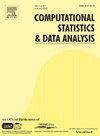High-dimensional response growth curve modeling for longitudinal neuroimaging analysis
IF 1.6
3区 数学
Q3 COMPUTER SCIENCE, INTERDISCIPLINARY APPLICATIONS
引用次数: 0
Abstract
There is increasing interest in modeling high-dimensional longitudinal outcomes in applications such as developmental neuroimaging research. Growth curve model offers a useful tool to capture both the mean growth pattern across individuals, as well as the dynamic changes of outcomes over time within each individual. However, when the number of outcomes is large, it becomes challenging and often infeasible to tackle the large covariance matrix of the random effects involved in the model. A high-dimensional response growth curve model, with three novel components, is proposed: a low-rank factor model structure that substantially reduces the number of parameters in the large covariance matrix, a re-parameterization formulation coupled with a sparsity penalty that selects important fixed and random effect terms, and a computational trick that turns the inversion of a large matrix into the inversion of a stack of small matrices and thus considerably speeds up the computation. An efficient expectation-maximization-type estimation algorithm is developed, and the competitive performance of the proposed method is demonstrated through both simulations and a longitudinal study of brain structural connectivity in association with human immunodeficiency virus.
纵向神经成像分析的高维反应增长曲线建模
在诸如发育神经成像研究等应用中,对高维纵向结果建模的兴趣越来越大。增长曲线模型提供了一个有用的工具,既可以捕捉个体之间的平均增长模式,也可以捕捉每个个体内部结果随时间的动态变化。然而,当结果数量很大时,处理模型中涉及的随机效应的大协方差矩阵就变得具有挑战性,而且往往是不可行的。提出了一种高维响应增长曲线模型,具有三个新的组成部分:一个低秩因子模型结构,它大大减少了大协方差矩阵中参数的数量;一个再参数化公式,加上选择重要的固定和随机效应项的稀疏性惩罚;一个计算技巧,它将一个大矩阵的反演转化为一堆小矩阵的反演,从而大大加快了计算速度。开发了一种高效的期望最大化型估计算法,并通过模拟和与人类免疫缺陷病毒相关的大脑结构连接的纵向研究证明了所提出方法的竞争性能。
本文章由计算机程序翻译,如有差异,请以英文原文为准。
求助全文
约1分钟内获得全文
求助全文
来源期刊

Computational Statistics & Data Analysis
数学-计算机:跨学科应用
CiteScore
3.70
自引率
5.60%
发文量
167
审稿时长
60 days
期刊介绍:
Computational Statistics and Data Analysis (CSDA), an Official Publication of the network Computational and Methodological Statistics (CMStatistics) and of the International Association for Statistical Computing (IASC), is an international journal dedicated to the dissemination of methodological research and applications in the areas of computational statistics and data analysis. The journal consists of four refereed sections which are divided into the following subject areas:
I) Computational Statistics - Manuscripts dealing with: 1) the explicit impact of computers on statistical methodology (e.g., Bayesian computing, bioinformatics,computer graphics, computer intensive inferential methods, data exploration, data mining, expert systems, heuristics, knowledge based systems, machine learning, neural networks, numerical and optimization methods, parallel computing, statistical databases, statistical systems), and 2) the development, evaluation and validation of statistical software and algorithms. Software and algorithms can be submitted with manuscripts and will be stored together with the online article.
II) Statistical Methodology for Data Analysis - Manuscripts dealing with novel and original data analytical strategies and methodologies applied in biostatistics (design and analytic methods for clinical trials, epidemiological studies, statistical genetics, or genetic/environmental interactions), chemometrics, classification, data exploration, density estimation, design of experiments, environmetrics, education, image analysis, marketing, model free data exploration, pattern recognition, psychometrics, statistical physics, image processing, robust procedures.
[...]
III) Special Applications - [...]
IV) Annals of Statistical Data Science [...]
 求助内容:
求助内容: 应助结果提醒方式:
应助结果提醒方式:


